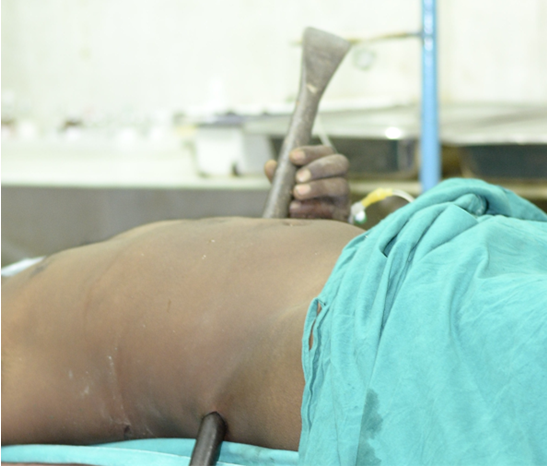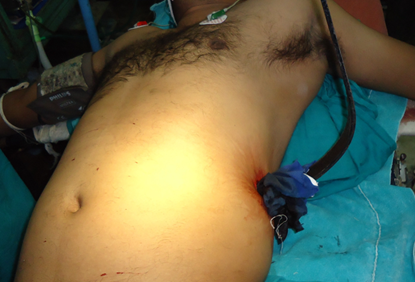Introduction
Abdominal impalement injuries are relatively uncommon and only a few cases have been reported in the literature. The resulting injuries can be challenging to diagnose and treat. Unlike blunt abdominal trauma, impalement injury requires mandatory exploratory laparotomy1, 2, 3 because often the nature and extent of the injury cannot be diagnosed preoperatively. In this report we present two unusual cases of abdominal impalement who presented in our emergency, review the literature in this context and discuss the approach to treatment in such cases.
Case Report
Case-1
A 26 years old male while digging at a construction site with an iron rod was impaled by it when a heavy chunk of concrete fell from above on his back. The rod penetrated through his upper abdomen just left of the midline and exited through the posterior axillary line in the right lumbar region just below the level of the umbilicus. The patient initially reported to a local hospital where the attending surgeon, citing lack of infrastructural facility, referred him to our tertiary care hospital, with the rod in situ. The patient reporting, approximately four hours following the incidence, was found to be in stable condition with vital parameters of, pulse rate 92/minute, blood pressure 132/82 mm of Hg, respiratory rate 30/ minute, and temperature 97oF. He had no evidence of significant blood loss or any apparent clinical features of neurological deficit, chest or skeletal injures. Baseline blood reports as done at bedside showed normal Hb% and PCV. After intravenous access with a wide bore cannula, arrangements for cross-matched blood, catheterization, administration of a single dose of injection cefuroxime (1.5gm), and anti-tetanus immunoglobulin (500 IU i.v.) he was transferred to the operating room after taking proper informed consent. No time was wasted for other preoperative hematological and radiological investigations. Vascular surgeons and urologists were informed beforehand as their help might be required after exploration. We were able to position him supine on the operating table with the rod protruding outside the table to the left (Figure 1). There was no difficulty during general anesthesia. Exploratory laparotomy was done through a liberal midline incision separate from the wound of entry. The foreign body was found to have penetrated through the posterior and anterior walls of the stomach at the junction of its upper 2/3rd and lower 1/3rd, passing anterior to the 2nd part of the duodenum and right kidney without injuring either of these structures. Finally, it exited the abdomen after penetrating through the upper part of the ascending colon. There was hardly any peritoneal spillage of gut content. The object was carefully dislodged and major vascular injury was excluded.
Injuries to the stomach were repaired in 2 layers with absorbable sutures. Injury to the trunk of Laterjet nerves could be grossly excluded by the position of the perforations. Right hemicolectomy was done considering the lacerated nature of the colonic injury. Drains were placed in the lesser sac and right paracolic gutter after thorough peritoneal toileting. Postoperative recovery was uneventful except for entry site infection. The patient tolerated orally since the 4th postoperative day and was discharged when he was tolerating diet and passing stool normally.
Case: 2
24 years old male while traveling at the rear seat of a bus was impaled by an angled piece of an iron plate (forming the outer framework of the bus) through his left loin just below the left costal arch. The incident occurred when another speeding bus collided from the rear aspect. He was brought to the hospital within half an hour with the foreign body in situ. The vital parameters at the time of presentation were, pulse 96/ minute, blood pressure 120/80 mm of Hg, respiratory rate of 25/minute, and temperature of 97o F. There was no obvious abnormality on the abdominal, chest, and neurological examination. Bedside blood tests revealed normal Hb% and PCV. After initial management as described above, he was transferred to the operating room after taking informed consent for anesthesia and surgery. After induction of anesthesia in the supine position, the position of the patient was changed to 30o right lateral and abdomen was explored through left flank muscle splitting incision starting from the point of entry and following its trajectory. The object was found to traverse just behind the posterior peritoneum and anterior to the erector spinae muscle. The peritoneum was not breached at any point. There was no other detectable retroperitoneal injury. The peritoneal cavity was explored and intra-abdominal visceral injury was excluded. The abdomen was closed with a retroperitoneal drain. Postoperative recovery was uneventful. The patient tolerated orally from the 2nd postoperative day, the drain was removed on the 3rd postoperative day, and he was discharged when he was tolerating diet and passing stool normally.
Discussion
Impalement injuries occur when a solid object pierces a body cavity or extremity, usually with great force. These are rare forms of penetrating injury after the other two commoner forms namely stab wound and gunshot wound. Impalement injuries are of two types- type I and type II.4 Type I injuries occur when a human body in motion strikes an immobile object (as in case 1), and type II injuries occur when a mobile object collides with an immobile person (as in case 2).4 Although this classification scheme may be useful for documentation, it does not affect how impalement injuries are managed.
In both of our cases, the patients were brought to the hospital with the impaled object in situ. This practice of not attempting removal of the impaled object before or during transport to the hospital from the site of the accident is crucial because the impaled object might be tamponading a major vessel. Removal of such objects before transferring to a hospital might be fatal because of severe hemorrhage.
About 150 years ago this practice of leaving impaling arrow shafts undisturbed was advocated by Dr. JH Bill. His conclusion about the tamponade effect of missiles on the surrounding injured vasculature was based on postmortem examinations.5, 6, 7 Rapid transport and cautious removal with minimum manipulation of the impaled object are the essences of avoiding the loss of tamponade effect.
In both of our cases, we transferred the patients to the operating room without wasting vital time in investigations. Because of multiple life-threatening injuries, their unknown nature, and their extent, perioperative management of abdominal impalement presents a challenge for anesthesia and surgery. Most reports suggest that patients in these situations should be rapidly assessed by a targeted examination. Radiographic or other time-consuming investigations should not delay definitive management.8
The impaled object often causes difficulty in positioning during anesthesia. Fortunately, in both of our cases, the patients could be positioned without much difficulty with the impaled object protruding outside the operating table. Super-specialty help was ready in case they were required. A multidisciplinary approach is often required in such cases depending on the extent of the injury.
Gastric injuries can be repaired by single-layer full-thickness sutures due to good vascularity unless there is a gross lacerated injury when resection is required. Injury to nerves of Laterjet requires drainage procedure. Colonic injuries can be managed by primary repair with or without resection and proximal diversion.9 In case 1 as the patient’s general condition was good but margins of the injured segment of the colon appeared to be unhealthy we decided on a right hemicolectomy.
Conclusion
Impalement injuries are rare causes of penetrating abdominal injuries as compared to stab or gunshot wounds. Primary success in the management lies in rapid transportation to a surgical facility with the provision of multi-disciplinary help without any attempt to remove the impaling object outside the operating room. The extent of injuries can be determined after exploration.



